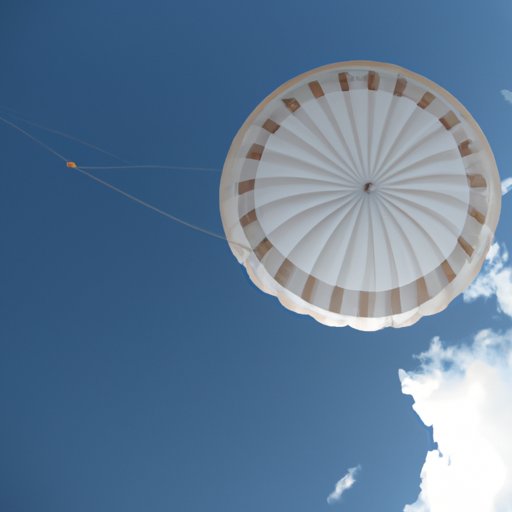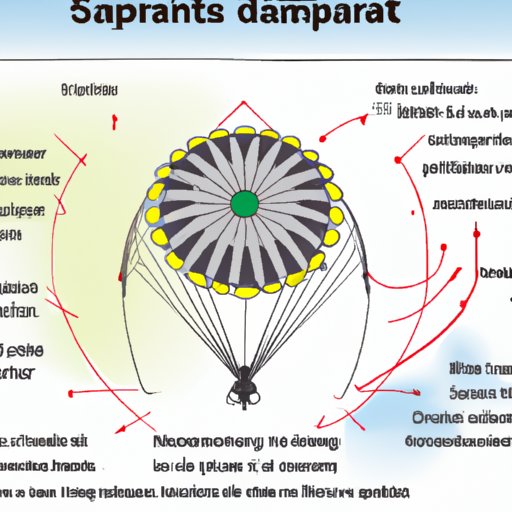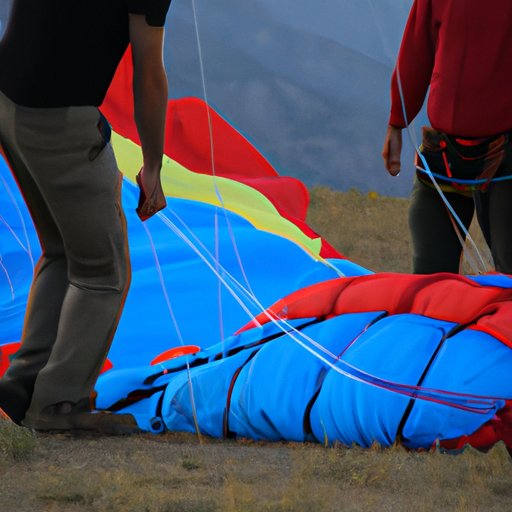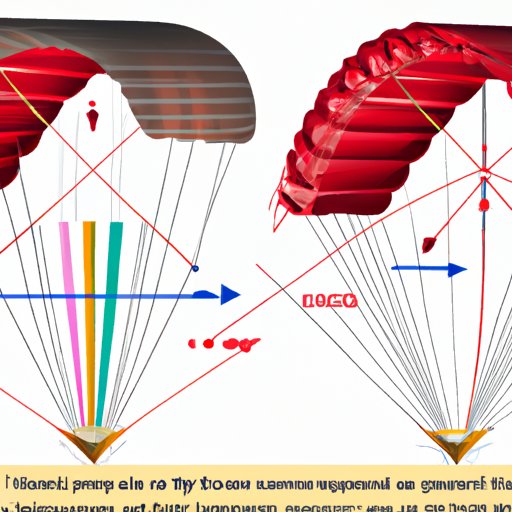Introduction
A parachute is an essential piece of equipment used by skydivers, allowing them to safely descend from high altitudes. But what exactly is a parachute and how does it work? In this article, we’ll explore the physics and engineering principles behind the functionality of parachutes, as well as how they make skydiving safer.

Exploring the Physics Behind How a Parachute Works
The physics behind a parachute are quite complex and require an understanding of the forces at play. To begin with, there is gravity, which acts in a downward direction and is the primary force that pulls a skydiver towards the ground. In addition to this, there is air resistance, which acts in the opposite direction to gravity and can slow down a skydiver’s descent.
The dynamics of drag are also important when considering how a parachute works. The shape of a parachute acts like an airfoil, meaning that it creates lift when air passes over it. This lift can be used to slow down a skydiver’s descent, thus making it safer for them to land. Furthermore, the size of a parachute can affect the amount of drag produced, with larger parachutes providing more drag than smaller ones.
Finally, the effect of air resistance is crucial to consider when looking at how a parachute works. Air resistance is created when air molecules collide with the surface of a parachute, and this can help to reduce the speed of a skydiver’s descent.
Step-by-Step Guide to Understanding How a Parachute Works
When a skydiver jumps out of an airplane, their first step is to open and deploy the parachute. This process involves pulling a ripcord, which causes the parachute to unfurl and catch the air. Once the parachute is open, the skydiver begins to slow down their descent, as the air passing over the parachute produces lift and drag.
The next step is the descent and landing phase. During this time, the skydiver can control the direction and speed of their descent using the parachute’s steering toggles. They can also use their body position to adjust the rate of descent, as well as any other adjustments needed to ensure a safe landing.

The Science of Parachutes: A Comprehensive Overview
In order to understand how a parachute works, it’s important to look at the science behind their design, materials, and testing. Parachute design plays a major role in their functionality, as different designs can produce different amounts of lift and drag. For instance, round parachutes with several gores (panels) tend to provide more lift and drag than square parachutes.
The materials used for parachutes also have an impact on their performance. Typically, parachutes are made from lightweight fabrics such as nylon or silk, as these materials can provide enough strength and durability for a safe descent. Additionally, the fabric must be able to withstand extreme temperatures and pressures, as parachutes are often deployed at high altitudes.
Finally, parachute testing is essential to ensure safety and reliability during a skydive. Parachute testing involves examining the fabric, stitching, lines, and other components to ensure they meet certain specifications. Tests may also be conducted in wind tunnels to assess the performance of the parachute under various conditions.
Parachutes: A Look at the Engineering Principles Behind Their Functionality
When considering the engineering principles behind parachutes, it’s important to look at the aerodynamic forces involved. These forces include lift and drag, which act upon the parachute when it is deployed. Lift is generated by the airflow across the top surface of the parachute, while drag is generated by the airflow across the bottom surface.
In addition to lift and drag, another important factor is parachute stability. This refers to how well the parachute remains open and resists collapsing during flight. Factors such as line length, canopy shape, and suspension lines can all affect parachute stability.

Examining the Mechanics of Parachutes and How They Slow Down Descent
To understand the mechanics of parachutes and how they slow down descent, it’s important to look at air resistance. When air passes over the surface of the parachute, it creates drag, which reduces the speed of the skydiver’s descent. Additionally, the air resistance also helps to reverse the momentum of the skydiver, causing them to slow down even further.
Another factor that can affect the rate of descent is the angle of attack. This refers to the angle at which the parachute is deployed relative to the airflow. If the angle of attack is too steep, the parachute will not generate enough lift and drag to slow down the skydiver’s descent. On the other hand, if the angle of attack is too shallow, the parachute will not be able to generate enough lift and drag to slow down the skydiver’s descent.
How Parachutes Make Skydiving Safer: An In-Depth Analysis
Parachutes are essential to skydiving safety, as they allow skydivers to safely descend from high altitudes. There are a number of safety benefits associated with parachutes, such as the ability to control the descent rate and the ability to maneuver the parachute to avoid hazards.
In the event of an emergency, parachutes can also be deployed quickly and efficiently. This allows the skydiver to slow down their descent rate and make a safe landing. Additionally, parachutes can also be used to deploy rescue systems such as life rafts and inflatable slides.
Finally, parachutes can also help to mitigate risks associated with skydiving. By reducing the skydiver’s descent rate, parachutes can help to minimize the risk of injury or death. Additionally, parachutes can also be used to deploy safety devices such as backup parachutes or reserve chutes.
Conclusion
As this article has explored, parachutes are an essential tool for skydivers, allowing them to safely and efficiently descend from high altitudes. The physics and engineering principles behind their functionality are complex and involve an understanding of aerodynamic forces, air resistance, and parachute design. Additionally, parachutes also play an important role in skydiving safety, providing numerous safety benefits and mitigating risks associated with the sport.
(Note: Is this article not meeting your expectations? Do you have knowledge or insights to share? Unlock new opportunities and expand your reach by joining our authors team. Click Registration to join us and share your expertise with our readers.)
